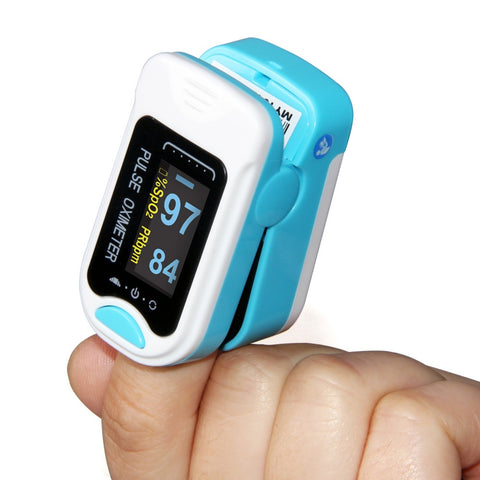An exercise pulse oximeter measures the level of oxygen in your blood during exercise and is a useful tool for serious athletes.The Pro Series CMS50N Fingertip Pulse Oximeter is manufactured according to the CE and FDA standards set for pulse oximeters used by doctors and other health professionals. Designed for sports enthusiasts, pilots or anyone who wants to obtain their SpO2 (Blood Oxygen Saturation Levels) and PR (Pulse Rate) on the go, the pulse oximeter OLED display now faces the user so that the user can read it easily. The pulse oximeter can now SpO2 up to 100%! Taking a reading is easy, just clip it onto your finger and turn it on at the press of a button.

- ACCURATE AND RELIABLE - Accurately determine your SpO2 (blood oxygen saturation levels), pulse rate and pulse strength in 10 seconds and display it conveniently on a large digital LED display.
- SPORT/HEALTH ENTHUSIASTS - For sports enthusiasts like mountain climbers, skiers, bikers or anyone interested in measuring their SpO2 and pulse rate. SpO2 and Pulse Rate now faces instead of away from the user for easy read.
- PRO SERIES -Manufactured according to CE and FDA standards for pulse oximeters used by doctors and other health professionals. The ONLY LED pulse oximeter that can read and display up to 100% for SpO2 value.
- SUITABLE FOR ALL AGES - Finger chamber with SMART Spring System. Accommodates wide range of finger sizes.
- LOADED WITH ACCESSORIES - A CARRING BAG to protect your pulse oximeter from dirt and damage and a LANYARD for convenience. Comes with 12 months WARRANTY and USA based technical phone support. Accurate and sensitive Get readings even if blood perfusion index is as low as 0.2%
Technical Details:
SpO2 Range: 0% - 100%
Accuracy: ±2%
SpO2 Resolution: ±1%
Pulse Rate Range: 30-250bpm
Accuracy: ±2bpm
Pulse Rate Resolution: ±1bpm Perfusion Index: 0.1% - 10%
Battery Life: 40 Hours
OLED Display
Multi-Directional Display
Powered by 2 AAA batteries (not included)
Dimension: 2.6(L) × 1.4(W) × 1.3(H) inches
Weight: About 50g

How Oximeter Works
During exercise, you breathe more heavily and more rapidly and your heart rate increases to supply muscles with needed oxygen. A pulse oximeter can be used during exercise to measure the oxygen saturation of your blood. Your pulse oximeter measurement naturally lowers during exercise because of changes that occur in oxygen-binding properties of red blood cells. Specific measurements vary depending on your health situation and exercise intensity.
A pulse oximeter is a non-invasive piece of equipment, often used in a health-care setting, typically placed on the end of your finger to measure your blood's oxygen saturation. The device uses red and infrared lights to measure the percentage of hemoglobin, which carries oxygen throughout your body. Measuring this way is possible because hemoglobin is a different color with and without oxygen, and absorbs different amounts of light depending on oxygen level. The difference between the amount of absorption provides a fairly accurate level of your oxygen saturation. Normal readings are between 95 and 100 percent. A reading below 90 percent is too low and may indicate hypoxemia, or low blood oxygen.

Benefits of Measurement During Exercise
An exercise pulse oximeter measures the level of oxygen in your blood during exercise and is a useful tool for serious athletes and people with health problems. For example, athletes routinely engaging in vigorous exercise, particularly at high altitudes, may wear pulse oximeters to ensure adequate oxygenation. Those with respiratory illnesses or recovering from surgery, meanwhile, may find wearing an exercise pulse oximeter during exercise useful for monitoring oxygen levels, the Pulse Oximeters website notes.
How to Use a Finger Pulse Oximeter
Step 1
Turn on the pulse oximeter by firmly pressing the power button. The screen should light up almost instantly.
Step 2
Place the sensor -- the part that opens and closes like a clothespin -- on any finger, with the sensor screen above the fingernail. If the sensor doesn't have a screen, run the cable along the back of the finger or hand. Don't use the thumb because readings are less reliable than finger readings.
Step 3
Wait quietly while the pulse oximeter acquires a signal. This may take 10 seconds or more, depending on the device and the conditions. Excessive movement during measurement can decrease the accuracy of the result or may cause an error message.
Step 4
Look at the display to see the heart rate, usually indicated with a heart or pulsing light. The percent of oxygen saturation is typically indicated by the symbol "SpO2." Many devices also have a pulse tone that beeps in time with the heart rate.
Step 5
Leave the sensor on for continuous monitoring. The sensor can become uncomfortable or cause pressure sores if left on the finger too long. If only a single measurement is required, remove the sensor and press the power button to turn off the device.
Legal Disclaimer:
Caution: This unit is not a medical device and is not intended to diagnose or treat any medical condition or disease. For additional information about a product, please contact the manufacturer. Content on this site is for reference purposes and is not intended to substitute for advice given by a physician, pharmacist, or other licensed health-care professional. You should not use this information as self-diagnosis or for treating a health problem or disease. Contact your health-care provider immediately if you suspect that you have a medical problem. This product should be used for sports and aviation only.
Actual product packaging and materials may contain more and different information than what is shown on our website. We recommend that you do not rely solely on the information presented and that you always read labels, warnings, and directions before using or consuming a product.












